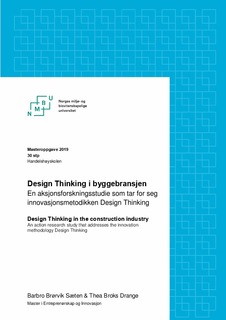| dc.contributor.advisor | Lunnan, Anders | |
| dc.contributor.advisor | Nyrud, Anders Qvale | |
| dc.contributor.advisor | Kubberød, Elin | |
| dc.contributor.author | Drange, Thea Broks | |
| dc.contributor.author | Sæten, Barbro Brørvik | |
| dc.date.accessioned | 2019-07-23T12:52:52Z | |
| dc.date.available | 2019-07-23T12:52:52Z | |
| dc.date.issued | 2019 | |
| dc.identifier.uri | http://hdl.handle.net/11250/2606315 | |
| dc.description.abstract | Bakgrunn: Byggebransjen er en tradisjonsrik bransje som lenge har vært preget av lav innovasjonsgrad og god tilgang på prosjekter. Et inntog av flere utenlandske selskaper på det norske markedet har ført til et behov for omstilling for å holde seg konkurransedyktig. Det er derfor interessant å undersøke om moderne innovasjonsmetodikk kan benyttes for å øke verdiskapingen hos norske aktører i denne konservative bransjen.
Hensikt: Hensikten med denne studien har vært å undersøke hvorvidt Design Thinking kan tilføre en verdi til vår casebedrift, Splitkon. Vi ønsker å se hvordan Design Thinking som innovasjonsmetodikk kan bidra til innsiktsfulle og effektive prosesser. For å svare på dette har vi satt opp følgende problemstilling: Hvordan kan Design Thinking benyttes til å drive frem innovasjoner i Splitkon, og hvordan kan en slik metodikk utvikle innovasjonspraksis?
Metode: For å besvare problemstillingen er aksjonsforskning benyttet som metodetilnærming. Det er blitt gjennomført en fullverdig Design Thinking-prosess, i tre faser. Kvalitative datainnsamlingsmetoder som dybdeintervju, observasjoner og workshop har stått sentralt. Informantene som har deltatt i studien har alle erfaring med massivtre og overflatebehandling, og har hatt bakgrunner som byggherrer, arkitekter, byggingeniører og fageksperter.
Funn og implikasjoner: Studien har kartlagt Design Thinking-prosessens tre faser; Brukerbehov, Idégenerering og Testing. Studien har bidratt med innsikt til videreutvikling av Splitkon sitt konsept rundt industrielt overflatebehandlet massivtre. Det var spesielt fokuset på Brukerbehov og Testing som gav nye, verdifulle resultater for konseptutviklingen. Gjennomføring av prosessen gav også gode implikasjoner for at Design Thinking kan bidra til en bevisstgjøring og systematisering av innovasjonspraksis hos Splitkon og at det kan hjelpe dem til å holde fokuset på kundenes behov. Implementering av nye prosesser vil være en kompleks oppgave, som krever innsats og motivasjon fra bedriften, men vi håper studien motiverer til å implementere Design Thinking som innovasjonspraksis. | nb_NO |
| dc.description.abstract | Background: The construction industry is characterized by tradition and has for a long time had a low degree of innovation and a large number of projects. An increase in the number of foreign companies on the Norwegian market has led to a need for reconstructing in order to remain competitive. This makes it interesting to examine whether modern innovation methodology can be used to increase the Norwegian actors’ value creation in this conservative industry.
Purpose: The purpose of this study has been to examine whether Design Thinking can create value for our case company, Splitkon. We want to examine how Design Thinking can contribute to insightful and effective processes, as an innovation methodology. To answer this, we have defined the following research question: How can Design Thinking be used to drive innovation at Splitkon, and how can such a methodology develop innovation practices?
Method: To answer the research question, action research is used as a method approach. A full Design Thinking process has been carried out in three phases. Qualitative data collection methods such as in-depth interviews, observations and workshops have been the focus. The informants participating in the study have all experience with Cross Laminated Timber (CLT) and surface treatment, and they have different backgrounds within professions such as builders, architects, construction engineers and subject experts.
Findings and implications: The study has mapped the three stages of the Design Thinking process; User Needs, Idea Generation and Testing. The study has contributed insight to the further development of Splitkon’s concept for industrial surface-treated CLT. It was especially the use of User Needs and Testing that gave new, valuable results for the concept development. The process also provided implications that Design Thinking can contribute to awareness and systematization of Splitkon’s innovation practices, and that it can help them stay focused on customer needs. Implementation of new processes can be a complex task, which requires effort and motivation from the company. But we hope that this study motivates implementation of Design Thinking as an innovation practice. | nb_NO |
| dc.language.iso | nob | nb_NO |
| dc.publisher | Norwegian University of Life Sciences, Ås | nb_NO |
| dc.rights | Attribution-NonCommercial-NoDerivatives 4.0 Internasjonal | * |
| dc.rights.uri | http://creativecommons.org/licenses/by-nc-nd/4.0/deed.no | * |
| dc.subject | Design Thinking | nb_NO |
| dc.title | Design Thinking i byggebransjen : en aksjonsforskningsstudie som tar for seg innovasjonsmetodikken Design Thinking | nb_NO |
| dc.title.alternative | Design Thinking in the construction industry : an action research study that addresses the innovation methodology Design Thinking | nb_NO |
| dc.type | Master thesis | nb_NO |
| dc.source.pagenumber | 93 | nb_NO |
| dc.description.localcode | M-EI | nb_NO |

